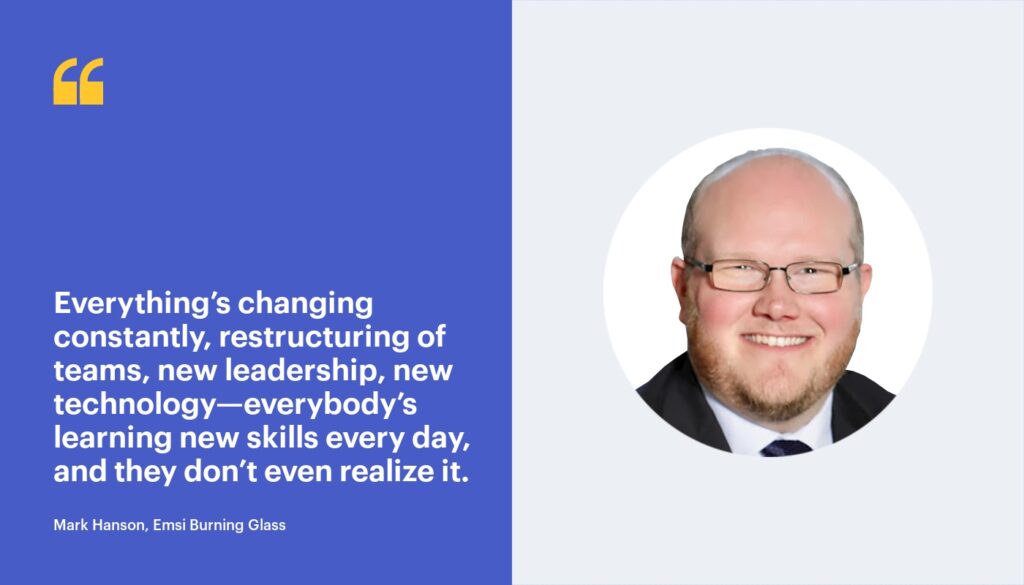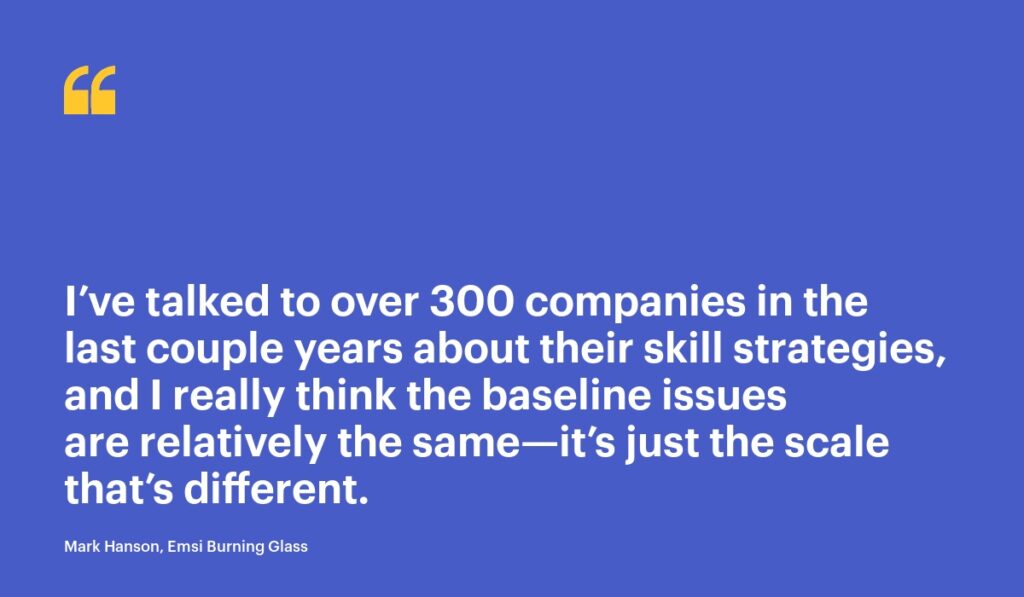Why Employee Skills Must Be Measured
To thrive in a changing marketplace, organizations know their employee skills data to make fast, accurate talent and business decisions.

To thrive in a changing marketplace, organizations have to make fast, accurate decisions about their people. That takes data—specifically, skill data. According to Mark Hanson of Emsi Burning Glass, that’s why interest in measuring, analyzing, and leveraging skill data has exploded in recent years.
As the leading provider of labor market data and analytics, Emsi Burning Glass knows skills better than almost anyone—and as Skills Product Owner, Mark Hanson has spent his career understanding these basic building blocks of how we get work done. We sat down with Mark to find out how working with skill data can benefit organizations, where to start, and how people analytics fits in.
Why do skills matter?
We look at skills as the foundational layer of work and learning. When you describe a job, you’re typically asking what skills are needed to accomplish a task or create value within a company. Then if you look at learning, we’re thinking about learning objectives, which are often tied to a skill that you need to pick up.
But every class, school, and program is slightly different, with different syllabi and learning objectives. So we open sourced our skill library to get everybody speaking the same language. It creates this efficiency in the marketplace if employers know exactly the skills that you’ve learned in school, and it’s the same skills that they’re asking for in job postings.
At Emsi Burning Glass, we think skills are the ultimate common language connector and translator between local economies, all of the things that the local governments tried to accomplish, what the schools are trying to accomplish, and what businesses are actually needing their people to do.

How do you measure skills?
We take a very basic approach. We simply ask: Does that skill exist? Do you have knowledge of it? We don’t put a level of proficiency on that skill, like many of our partners do.
Even though this is a very simple approach, it’s going to open up doors. For example, now you could be connected to learning that could help you get more proficient in that area, or the skills related to it. Or it could match you to jobs that you might be a fit for. At least, this kind of skill data can help you narrow down the thousands, even millions, of jobs that are posted out there.

How does this change things?
If you think about the old way, where companies just know people by their job title, it’s not enough. Instead, we need to understand the building blocks of what our people possess, and what skills are needed for which roles. That’s why skills really affect everything, from learning and development, to talent acquisition, to workforce planning, to operations teams.
For example, say you have a world-renowned Python expert on your team, but they’re sitting in an odd job title, say “data scientist” or “senior engineer.” If they leave, you have minimal knowledge of what skills just left your company.
Does company size make a difference?
I’ve talked to over 300 companies in the last couple years about their skill strategies, and I really think the baseline issues are relatively the same—it’s just the scale that’s different.
Everybody has problems with employee engagement. Everybody wants to remain relevant in the marketplace and keep driving innovation so that they can still exist tomorrow.
Big companies might have a little more cushion in terms of the financials, but when a market downturn happens, it impacts them at a much greater dollar amount. And while smaller businesses do get hit a little bit harder, they’re really facing the same challenges when it comes to skill development, reskilling strategies, and talent mobility.

What skill metrics do HR leaders care about?
I think in general, HR leaders are relating skills to their talent picture. A lot of our HR leaders’ focus is on promoting the right talent, identifying high performers with the critical skill sets we need for the future, and giving them the best opportunities.
Especially at companies that are growing quickly, there’s a real need for succession and mobility plans, to make sure HR leaders are selecting the right people at the right times in their career path to enable them to stay with the company. So a lot of their metrics really revolve around talent movement and talent planning. But it’s still, at the core, about skills.
What magic happens when a company assesses skills correctly?
You have a deeper knowledge of your talent workforce. The magic is that you go from this broad, job title-level understanding, and you get to the core, not just of the person’s role, but their holistic skillset—all their previous career knowledge and different role knowledge.
Now you can make much better decisions about your talent, because you have the whole picture. Without that, companies waste millions of dollars trying to recruit for external talent, when the skills they need are sitting right down the hall and they just don’t know it’s there.
The magic is that you can finally have a holistic picture of your people and the uniqueness they’re bringing. You can tap into that and help them get to their full potential.

What is stopping companies from working with skills right now?
It’s just the identification of skills. Some companies will pull skills from their LinkedIn data, but then realize only 20% of their population even has a LinkedIn profile. Or they’ll create a great skill profile within their HRIS system, but only 10% of their employee base filled it out, because there’s zero incentive to do so. That amount of data doesn’t really help you—you need to be pushing more for that 90%-100% capture.
It’s a moving problem. Everything’s changing constantly, restructuring of teams, new leadership, new technology—everybody’s learning new skills every day, and they don’t even realize it. That’s why the biggest thing companies are looking for from us is our open-source skill library, because it’s updated every two weeks, in connection with the labor market.
What’s the best first step?
I think every company should be building skill profiles for all the job titles within their workforce—basically appending their job descriptions. There’s no need to change the job titles or job descriptions because those are still valuable.
This is a much better first step than trying to capture the actual skills of the people sitting in those roles. It’s hard to incentivize people to give you their skills so don’t start there because you’re going to get really frustrated. But if you understand the skill behind your roles and job titles, that gives you at least a baseline knowledge.
This step also uses less resources. You don’t need this massive initiative of trying to deploy a huge system, or convincing thousands of people to take a survey that then needs to be kept up to date.
What role does people analytics play?
When it comes to the people analytics team, again, it’s all about that holistic picture of the talent. Before, they reported on job codes and job titles; it was this very narrow view. Skills data is going to expand all that reporting exponentially.
Think about measuring turnover by skills. What skills just left your four walls? Or in terms of manager effectiveness—can they manage certain skill sets especially well? What about engagement—are people with certain skill sets more engaged than others?
People analytics can tie all that to their core metrics. This is a whole new layer of data that’s going to make it much more granular, and give you a much truer sense of the people and the talent that’s in your business.
Ready to learn more? Download our Big Book of People Analytics: Skills to learn about what skills data is, why it’s so valuable, how companies can use it to plan their upskilling strategies, and why skill data and people analytics are such a powerful combination.


